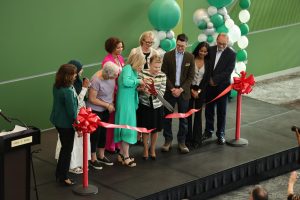NASA Discovers Seven Possibly Life-Supporting Planets
This illustration provided by NASA/JPL-Caltech shows an artist’s conception of what the TRAPPIST-1 planetary system may look like, based on available data about their diameters, masses and distances from the host star. The planets circle tightly around a dim dwarf star called Trappist-1, barely the size of Jupiter. Three are in the so-called habitable zone, where liquid water and, possibly life, might exist. The others are right on the doorstep. (NASA/JPL-Caltech via AP)
March 1, 2017
Just a few days ago NASA announced the discovery of seven exoplanets orbiting a very small dwarf star named TRAPPIST-1. These planets are a massive discovery because all have the ability to sustain human life. Depending on a few factors even the exoplanets closest to the star may be hospitable. What is more likely though is the that only three exoplanets are hospitable. These three are within “The Goldilocks Zone,” a place not too hot nor too cold.
“Three of these planets are in the habitable zone where liquid water could pool on the surface. With the right atmospheric conditions there could be water on any of these planets,” said, Associate Administrator at NASA Thomas Zurbuchen during a panel. Zurbuchen later went on to say, “the discovery gives us a hint, that finding a second Earth is not just a matter of if, but when.” This was from a panel with a few experts from NASA along with a few of the scientists that made the discover.
NASA still is not sure if any of the exoplanets have water, but they will most likely find out soon. NASA is also looking to find out if the exoplanets have atmospheres along with any sustainable atmospheres as well. The exoplanets were discovered by NASA using a telescope named TRAPPIST, actually the star itself was discovered in 2016 but the exoplanets were not until just recently.
TRAPPIST-1 is unfortunately 40 light-years away so with the technology we have now, it would take an estimated 44 million years to reach the planets. However if we were to discover how to travel at light speed it would only take around 39 years. Travel is obviously unlikely so the real potential lies with whether there may be life on the planets or not. Studying these planets and running tests is what NASA is focused on at the moment. As disappointing as the distance is, the discovery could develop into something monumental and hopefully any information collected from the discovery can be utilized for traveling to closer destinations like Mars. Also the research that is being done will be much more refined by next year as tests, heavy dedication and effort will go into this discovery.
The exoplanets are largely the same size as Earth but are extremely close to each other. For example, if you were standing on one of these planets you would be able to see the other neighboring planets zipping by in a size closer to the moon. The sun as well would be massive and would appear to be approximately twice the size of our sun, when in reality it is about one tenth the size of our own. Since these planets are so close to each other they orbit their star extremely quickly. We orbit our sun in 365 days, the closest exoplanet orbits in only 1.5. The farthest orbits in around 20 days.
At a panel with NASA, hosted by TIME Magazine just a few days ago, Professor of Planetary Science and Physics at MIT, Sara Seager said, “with this discovery we’ve made a giant accelerated leap forward in the search for habitable worlds and life on other worlds potentially speaking. Because with not just one planet but several, we have room that if we didn’t have the habitable zone quite right, or we weren’t sure quite what we’re looking for, we have many chances over. You could say locally, it’s like in this planetary system, Goldilocks has many sisters.”


















